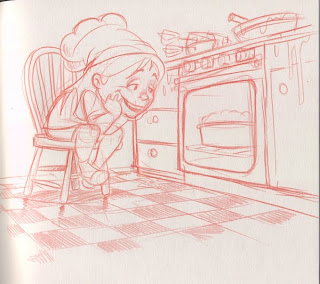Before I start with my painting I try to come up with a color concept first. For this piece I've got a very clear idea in my head. The oven is going to be the main lightsource in this piece. It is a wam light. To let the warm color be the most dominant I'm going to put the rest of the piece in a cooler color. This should create a clear focus point for the viewer.
Blocking in the color concept

So here is the result of the 1st idea I had for this piece. I tried to put in a warm color, orange/yellowish, for the lightsource. This lighting should bring out clearly the girl sitting in front of the oven. The rest of the kitchen is in a cooler purple/blueish color, so the girl gets the most attention. Keep it simple, not go into details, and try to keep my light and shadow clearly separated.
Critique/suggestions?
Now the trick in this stage is too look at your own work with a fresh pair of eyes. Try to look at it if you see it for the first time, is it working? What do I really see?
I am noticing a few things that need work.
First is that the oven and the girl have the same color. They both ask for your attention. I wanted the girl to be the first thing you see, that is not the case now.
Second thing I notice is that it is a little hard to see that there is a girl sitting. How she sits, her posture isn't working with this lighting. If she would be sitting more in front of the oven, I think, she would come out better.
Changes
So I am going to make some changes. I think the most important thing to change is the position and the pose of the girl sitting in front of the oven. I think coming up with a better silhouette for the girl, will improve the piece. I also have to think about the lighting while designing the new girl.
So back to the drawing board!







